萨尔瓦多国际经济学(第十版)
- 格式:ppt
- 大小:771.00 KB
- 文档页数:29
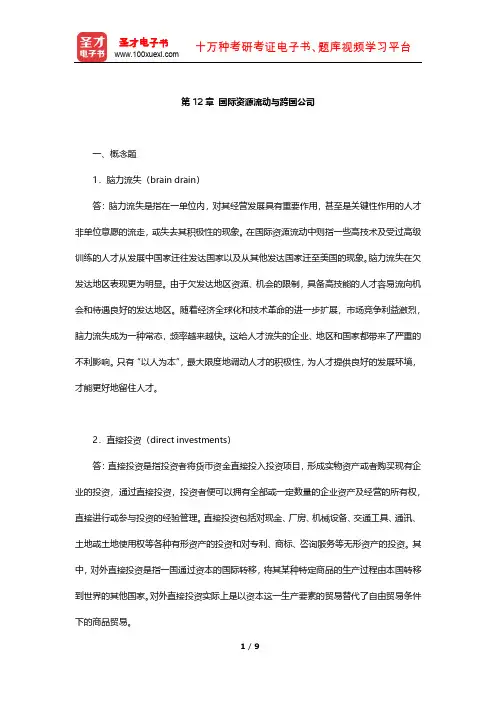
第12章国际资源流动与跨国公司一、概念题1.脑力流失(brain drain)答:脑力流失是指在一单位内,对其经营发展具有重要作用,甚至是关键性作用的人才非单位意愿的流走,或失去其积极性的现象。
在国际资源流动中则指一些高技术及受过高级训练的人才从发展中国家迁往发达国家以及从其他发达国家迁至美国的现象。
脑力流失在欠发达地区表现更为明显。
由于欠发达地区资源、机会的限制,具备高技能的人才容易流向机会和待遇良好的发达地区。
随着经济全球化和技术革命的进一步扩展,市场竞争利益激烈,脑力流失成为一种常态,频率越来越快。
这给人才流失的企业、地区和国家都带来了严重的不利影响。
只有“以人为本”,最大限度地调动人才的积极性,为人才提供良好的发展环境,才能更好地留住人才。
2.直接投资(direct investments)答:直接投资是指投资者将货币资金直接投入投资项目,形成实物资产或者购买现有企业的投资,通过直接投资,投资者便可以拥有全部或一定数量的企业资产及经营的所有权,直接进行或参与投资的经验管理。
直接投资包括对现金、厂房、机械设备、交通工具、通讯、土地或土地使用权等各种有形资产的投资和对专利、商标、咨询服务等无形资产的投资。
其中,对外直接投资是指一国通过资本的国际转移,将其某种特定商品的生产过程由本国转移到世界的其他国家。
对外直接投资实际上是以资本这一生产要素的贸易替代了自由贸易条件下的商品贸易。
3.横向一体化(horizontal integration)答:企业增长在战略上可分为一体化扩张和多样化扩张。
一体化扩张又可分为横向一体化(水平一体化)和纵向一体化(垂直一体化)。
横向一体化是指为了扩大生产规模、降低成本、巩固企业的市场地位、提高企业竞争优势、增强企业实力而与同行业企业进行联合的一种战略。
实质是资本在同一产业和部门内的集中,目的是实现扩大规模、降低产品成本、巩固市场地位。
国际化经营是横向一体化的一种形式。

第20章浮动与固定汇率、欧洲货币体系与宏观经济政策的协调20.1 复习笔记一、浮动汇率与固定汇率1.支持浮动汇率的理由(1)市场效率①在浮动汇率体系下,只需改变汇率就可以修正一国国际收支的失衡,成本低。
而在固定汇率下,只有国内所有商品价格都是灵活可变时,才能实现国际收支的有效调整。
②在国际收支失衡时可以平滑地、连续地进行修正,稳定投机活动,抑制汇率的波动。
③当均衡汇率转换为国内商品价格时,浮动汇率可清楚地识别一国各种商品的比较优势和劣势。
(2)政策优势①政府不必太关注外部收支均衡,能充分利用各种政策来实现稳定物价、充分就业、经济增长和收入的公平分配等国内目标。
②提高货币政策的实施效率,比如各国可以按照自己所希望实现的通胀-失业权衡目标来制定国内政策。
③阻止政府制定一个非均衡的汇率水平。
④免去政府在外汇市场中为维持汇率稳定所需的干预成本。
2.支持固定汇率的理由(1)减少不确定性①避免了浮动汇率下汇率日复一日的剧烈波动,从而可避免对专业化生产及贸易、资本流动的不利影响。
②固定汇率下的不确定性一般可以避免,而浮动汇率制度下则不能。
(2)稳定投机由于政府有稳定汇率的承诺,当汇率波动有可能超过上下限时,投资者预期政府将干预外汇市场,并改变买卖行为,所从事的外汇投机交易有助于市场汇率的稳定。
(3)价格规范自我抑制通货膨胀以稳定汇率。
二、最佳货币区、欧洲货币体系及欧洲货币联盟1.最佳货币区(1)定义最佳货币区理论是由蒙代尔和麦金农(McKinnon)于20世纪60年代创立的。
最佳货币区或国家货币集团指的是这样一些国家集体,它们的货币通过永久固定的汇率及其他使该区域变得理想化的条件联系在一起。
成员国货币的币值根据非成员国情况联合变动。
(2)优点①消除了由于汇率不固定而产生的不确定性,因此刺激了国际分工及在成员国之间或区域内的贸易与投资的流动。
最佳货币区的形成也使得生产商将整个区域视为一个市场,并可获得更多的生产的规模经济效益。
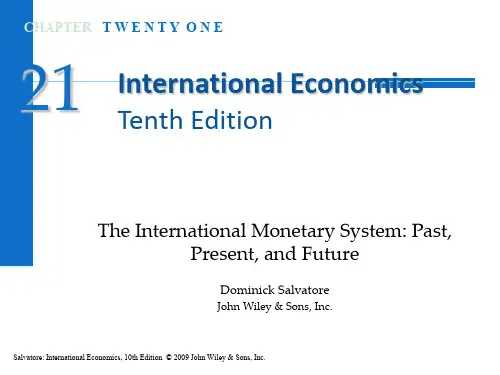

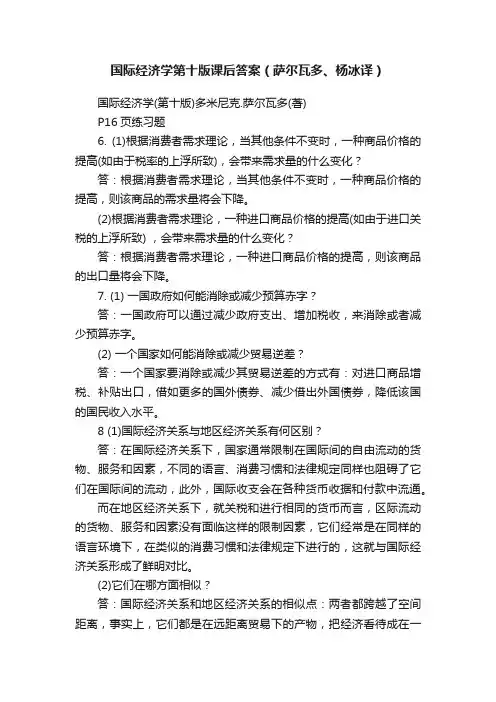
国际经济学第十版课后答案(萨尔瓦多、杨冰译)国际经济学(第十版)多米尼克.萨尔瓦多(著)P16页练习题6. (1)根据消费者需求理论,当其他条件不变时,一种商品价格的提高(如由于税率的上浮所致),会带来需求量的什么变化?答:根据消费者需求理论,当其他条件不变时,一种商品价格的提高,则该商品的需求量将会下降。
(2)根据消费者需求理论,一种进口商品价格的提高(如由于进口关税的上浮所致) ,会带来需求量的什么变化?答:根据消费者需求理论,一种进口商品价格的提高,则该商品的出口量将会下降。
7. (1) 一国政府如何能消除或减少预算赤字?答:一国政府可以通过减少政府支出、增加税收,来消除或者减少预算赤字。
(2) 一个国家如何能消除或减少贸易逆差?答:一个国家要消除或减少其贸易逆差的方式有:对进口商品增税、补贴出口,借如更多的国外债券、减少借出外国债券,降低该国的国民收入水平。
8 (1)国际经济关系与地区经济关系有何区别?答:在国际经济关系下,国家通常限制在国际间的自由流动的货物、服务和因素,不同的语言、消费习惯和法律规定同样也阻碍了它们在国际间的流动,此外,国际收支会在各种货币收据和付款中流通。
而在地区经济关系下,就关税和进行相同的货币而言,区际流动的货物、服务和因素没有面临这样的限制因素,它们经常是在同样的语言环境下,在类似的消费习惯和法律规定下进行的,这就与国际经济关系形成了鲜明对比。
(2)它们在哪方面相似?答:国际经济关系和地区经济关系的相似点:两者都跨越了空间距离,事实上,它们都是在远距离贸易下的产物,把经济看待成在一个进行着生产、交换和消费的空间中的单一点,这也是从经济学的复位空间将它们区分。
10.如果说一个国家可以从国际贸易中获益,那么你如何解释为什么许多国家又要对国际贸易施加某些限制?答:国际贸易给本国消费者带来的是更低的价格,这样就会对本国的同种商品的生产商造成不利,挤兑了本国生产商的销售份额。
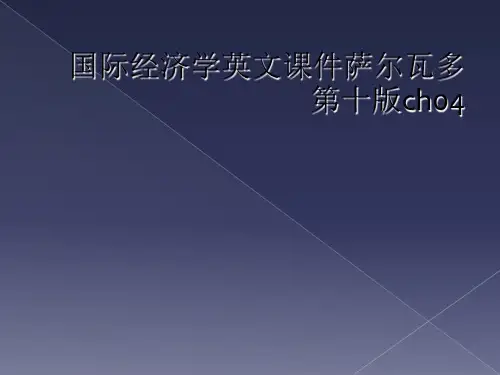
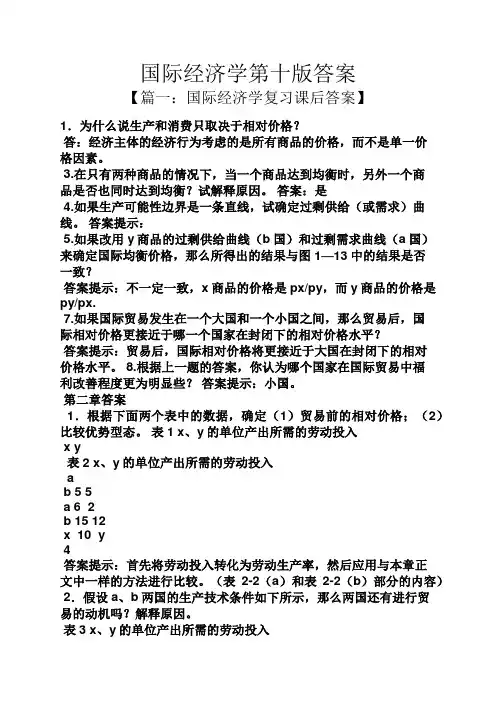
国际经济学第十版答案【篇一:国际经济学复习课后答案】1.为什么说生产和消费只取决于相对价格?答:经济主体的经济行为考虑的是所有商品的价格,而不是单一价格因素。
3.在只有两种商品的情况下,当一个商品达到均衡时,另外一个商品是否也同时达到均衡?试解释原因。
答案:是4.如果生产可能性边界是一条直线,试确定过剩供给(或需求)曲线。
答案提示:5.如果改用y商品的过剩供给曲线(b国)和过剩需求曲线(a国)来确定国际均衡价格,那么所得出的结果与图1—13中的结果是否一致?答案提示:不一定一致,x商品的价格是px/py,而y商品的价格是py/px.7.如果国际贸易发生在一个大国和一个小国之间,那么贸易后,国际相对价格更接近于哪一个国家在封闭下的相对价格水平?答案提示:贸易后,国际相对价格将更接近于大国在封闭下的相对价格水平。
8.根据上一题的答案,你认为哪个国家在国际贸易中福利改善程度更为明显些?答案提示:小国。
第二章答案1.根据下面两个表中的数据,确定(1)贸易前的相对价格;(2)比较优势型态。
表1 x、y的单位产出所需的劳动投入x y表2 x、y的单位产出所需的劳动投入ab 5 5a 6 2b 15 12x 10 y4答案提示:首先将劳动投入转化为劳动生产率,然后应用与本章正文中一样的方法进行比较。
(表2-2(a)和表2-2(b)部分的内容) 2.假设a、b两国的生产技术条件如下所示,那么两国还有进行贸易的动机吗?解释原因。
表3 x、y的单位产出所需的劳动投入x ya 4 2b 8 4答案提示:从绝对优势来看,两国当中a国在两种产品中都有绝对优势;从比较优势来看,两国不存在相对技术差异。
所以,两国没有进行国际贸易的动机。
3.如果一国在某一商品上具有绝对优势,那么也必具有比较优势吗?答案提示:不一定,比较优势的确定原则是两优取最优,两劣取最劣。
5.假设某一国家拥有20,000万单位的劳动,x、y的单位产出所要求的劳动投入分别为5个单位和4个单位,试确定生产可能性边界方程。
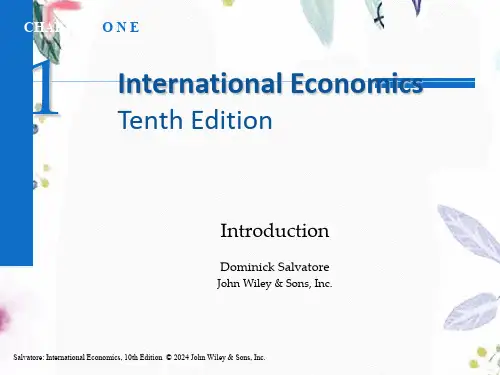
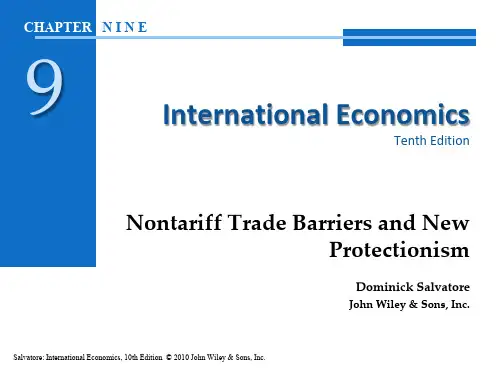
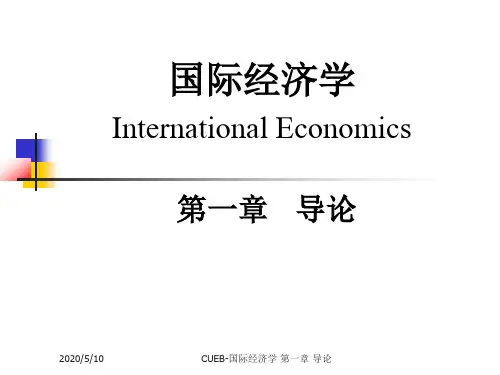
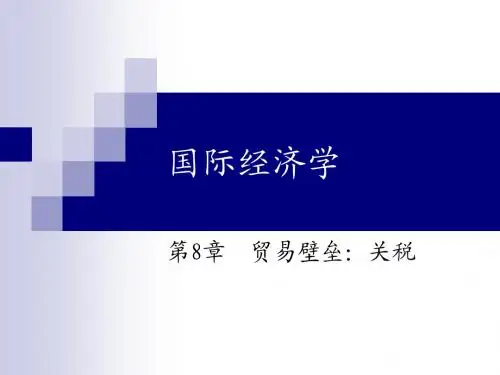
*CHAPTER 5(Core Chapter)TRADE RESTRICTIONS: TARIFFSOUTLINE5.1 Introduction5.2 Types of TariffsCase Study 5-1 Average Tariff on Industrial Products in Major Developed CountriesCase Study 5-2 Average Tariff on Industrial Products in Some Major Developing Countries 5.3 Effects of a Tariff in a Small Nation5.4 Effect of a Tariff on Consumer and Producer Surplus5.5 Costs and Benefits of a Tariff in a Small NationCase Study 5-3 The Welfare Effects of Liberalizing Trade in Some U.S. ProductsCase Study 5-4 The Welfare Effects of Liberalizing Trade in Some EU Products5.6 Costs and Benefits of a Tariff in a Large Nation5.7 The Optimum Tariff and Retaliation5.8 Theory of Tariff StructureCase Study 5-5 Rising Tariff Rates with Degree of Domestic ProcessingCase Study 5-6 Structure of Tariffs in the United States, EU, and CanadaAppendix: Optimum Tariff and Retaliation with Offer CurvesKey TermsTrade or commercial policies Revenue effect of a tariffsurplustariff ConsumerImportExport tariff Rent or producer surplustariff Protectioncost or deadweight loss of a tariff valoremAdSpecific tariff Terms of trade effect of the tarifftarifftariff OptimumCompoundConsumption effect of a tariff Prohibitive tariffProduction effect of a tariff Rate of effective protectionTrade effect of a tariffLecture Guide1. I would cover sections 1-4 in the first lecture. The most difficult part is Section 4 on themeaning and measurement of consumer and producer surplus. Since a clear understanding of the meaning and measurement of consumer and producer surplus is crucial in measuring the welfare effect of tariffs, I would explain these concepts very carefully.2. I would cover sections 5 and 6 in the second lecture. These are the most difficult sections inthe chapter and also the most important.3. The theory of tariff structure is also difficult and important. I found that the best way toexplain it is by using the simple example in the text on the suit with and without imported inputs. This section is likely to generate a great deal of discussion about the trade relations between developed and developing nations. If you do not plan to cover optional Chapter 8 on growth and development, you could spend a bit more time on this topic here , even though it will come up again in Chapter 6.Answer to Problems1. a. See Figure 1 on the next page.b. Consumption is 70X, production is 50X and imports are 20X.c. The consumption effect is –30X, the production effect is +30X, the trade effectis –60X, and the revenue effect is $30 (see Figure 1).2. a. The consumer surplus is $250 without and $l22.50 with the tariff (see Figure 1).b. Of the increase in the revenue of producers with the tariff (as compared with theirrevenues under free trade), $22.50 represents the increase in production costs andanother $22.50 represents the increase in rent or producer surplus (see Figure 1).c. The dollar value or the protection cost of the tariff is $45 (see Figure 1).3. The dollar value or the protection cost of the tariff is $45 (see Figure 2).4. The dollar value or the protection cost of the tariff is $45 (see Figure 3).5. The optimum tariff is the tariff that maximizes the net benefit resulting from theimprovement in the nation’s terms of trade against the negative effect resulting fromreduction in the volume of trade.X Fig 5.1X Fig 5.2XFig 5.36. a. When a nation imposes an optimum tariff, the trade partner’s welfare declines because ofthe lower volume of trade and the deterioration in its terms of trade.b. The trade partner is likely to retaliate and in the end both nations are likely to lose becauseof the reduction in the volume of trade.7. Even when the trade partner does not retaliate when one nation imposes the optimum tariff,the gains of the tariff-imposing nation are less than the losses of the trade partner, so that theworld as a whole is worse off than under free trade. It is in this sense that free trade maximizesworld welfare.8. a. The nominal tariff is calculated on the market price of the product or service. The rate ofeffective protection, on the other hand, is calculated on the value added in the nation. It isequal to the value of the price of the commodity or service minus the value of the importedinputs used in the production of the commodity or service.b. The nominal tariff is important to consumers because it determines by how much the priceof the imported commodity increases. The rate of effective protection is important fordomestic producers because it determines the actual rate of protection provided by thetariff to domestic processing.9. a. Rates of effective protection in industrial nations are generally much higher than thecorresponding nominal rates and increase with the degree of processing.b. The tariff structure of developed nations is of great concern for developing nationsbecause it discourages manufacturing production in developing nations.10. If a nation reduces the nominal tariff on the importation of the raw materials required toproduce a commodity but does not reduce the tariff on the importation of the finalcommodity produced with the imported raw material, then the effective tariff rates willincrease relative to the nominal tariff rate on the commodity.Multiple-choice Questions1. Which of the following statements is incorrect?a. an ad valorem tariff is expressed as a percentage of the price of the traded commodity.b. a specific tariff is expressed as a fixed sum of the value of the traded commodity.c. export tariffs are prohibited by the U.S. Constitution*d. the U.S. uses exclusively the specific tariff2. A small nation is one:a. which does not affect world price by its tradingb. which faces an infinitely elastic world supply curve for its import commodityc. whose consumers will pay a price that exceeds the world price by the amount of the tariff *d. all of the above3. If a small nation increases the tariff on its import commodity, its:a. consumption of the commodity increasesb. production of the commodity decreasesc. imports of the commodity increase*d. none of the above4. The increase in producer surplus when a small nation imposes a tariff is measured by the area: *a. to the left of the supply curve between the commodity price with and without the tariffb. under the supply curve between the quantity produced with and without the tariffc. under the demand curve between the commodity price with and without the tariffd. none of the above.5. If a small nation increases the tariff on its import commodity:*a. the rent of domestic producers of the commodity increasesb. the protection cost of the tariff decreasesc. the deadweight loss decreasesd. all of the above6. The imposition of an optimum tariff by a small nation:a. improves its terms of tradeb. reduces the volume of tradec. increases the nation's welfare*d. non of the above7. The optimum tariff for a small nation is:a. 100%b. 50%*c. 0d. depends on the elasticity of demand and supply for the import commodity in the nation8. The imposition of an optimum tariff by a large nation:a. improves its terms of tradeb. reduces the volume of tradec. increases the nation's welfare*d. all of the above9. The imposition of an optimum tariff by a large nation:a. improves the terms of trade of the trade partner*b. reduces the volume of tradec. increases the trade partner’s welfared. all of the above10. If two large countries impose an optimum tariff*a. the welfare of the both nations decreaseb. the welfare of the both nations increasec. the welfare of the larger nation will increase and that of the other nation decreasesd. the welfare of the larger nation will decrease and that of the other nation increases11. If one nation imposes an optimum tariff and the other nation does not retaliate*a. the welfare of the first nation increases and that of the welfare of the second nation fallsb. the welfare of the second nation increases and that of the welfare of the second nation fallsc. the welfare of both nations falld. the welfare of both nations increase12. If one nation imposes an optimum tariff and the other nation does not retaliatea. the welfare of the first nation increases more than the fall in the welfare of the secondnation*b. the welfare of the first nation increases more than the fall in the welfare of the secondnationc. the welfare of the second nation increases less than the fall in the welfare of the firstnationd. the welfare of the first nation increases by the same amount as the fall in the welfare of the second nation13. The nominal tariff is the tariff calculated on thea. price of the input used in the production of the commodity*b. price of the commodity or servicec. value addedd. all of the above14. The effective tariff rate is the tariff calculated on thea. price of the input used in the production of the commodityb. commodity or service*c. value added in the nationd. all of the above15. If the nominal tariff on a commodity is higher than the nominal tariff on the imported input used in the production of the commodity, then the rate of effective protection is*a. higher on the commodity than on the inputb. lower on the commodity than on the imported inputc. equal on the commodity and on the imported inputd. any of the above。
国际经济学教案——萨尔瓦多——第十版【正文】本篇文章将为您提供一份关于国际经济学的教案,重点关注了萨尔瓦多的相关内容。
这是第十版,详细介绍了萨尔瓦多在国际经济领域的重要性以及其相关的经济特征。
通过本教案,您将了解到萨尔瓦多的经济状况、贸易情况以及国际经济学中的相关理论和案例研究。
一、简介萨尔瓦多是位于中美洲的国家,是世界上最小的国家之一。
它以其独特的地理位置、文化传统和经济特征而闻名于世。
本节将介绍萨尔瓦多的基本情况,包括国土面积、人口数量、首都城市等。
二、经济特征萨尔瓦多的经济发展受到多种因素的影响,包括历史、地理和政治等。
本节将介绍萨尔瓦多经济的主要特征,包括主要产业、经济结构和劳动力市场等方面。
1. 主要产业萨尔瓦多的主要产业包括农业、制造业和服务业等。
它以咖啡、糖、纺织品和制衣等农产品和制造业产品闻名于世。
本节将详细介绍这些主要产业的特点和对萨尔瓦多经济的贡献。
2. 经济结构萨尔瓦多经济的结构主要由农业、制造业和服务业构成。
本节将分析这些行业在萨尔瓦多经济中的比重,并探讨其对GDP和就业的影响。
3. 劳动力市场萨尔瓦多的劳动力市场状况对经济发展起着重要作用。
本节将介绍萨尔瓦多的劳动力市场现状,包括就业率、失业率和工资水平等方面的情况,并探讨其中的挑战和机遇。
三、贸易状况贸易对于萨尔瓦多的经济增长和发展至关重要。
本节将详细介绍萨尔瓦多的进出口情况,包括主要贸易伙伴、贸易顺差/逆差以及贸易政策等方面的内容。
1. 主要贸易伙伴萨尔瓦多的主要贸易伙伴包括美国、中国、哥伦比亚等国家。
本节将分析这些国家与萨尔瓦多的贸易合作情况,并探讨其中的优势和劣势。
2. 贸易顺差/逆差萨尔瓦多的贸易顺差/逆差对于国家经济稳定与发展起着重要作用。
本节将介绍萨尔瓦多的贸易顺差/逆差情况,并分析其原因和影响。
3. 贸易政策贸易政策对于萨尔瓦多的经济发展具有重要意义。
本节将介绍萨尔瓦多的贸易政策,包括关税政策、自由贸易协定和贸易保护主义等方面的内容。
第3章国际贸易的标准理论一、概念题1.自给自足(autarky)答:自给自足特指在经济上完全依靠自己的力量来满足各种需要,而不与外部世界发生任何贸易关系。
在工业社会以前,大部分国家都处于自给自足的状态,经济发展落后,彼此间交流沟通很少。
这种情况的自给自足是狭隘的,因为本国的生产要素使用没有达到最优状态,且人民物质生活比较贫乏。
当前,随着经济的发展,有些国家由于要素禀赋的充裕以及技术的革新,有些产品生产上已经实现了自给自足。
2.社会无差异曲线(community indifference curve)答:社会无差异曲线是表明一个国家或经济体保持等量的国民消费水平或福利水平的两种商品的各种消费量组合点的轨迹。
或者说,它是显示社会福利水平为一常数的各种消费选择。
每一条社会无差异曲线都代表一定的社会效用水平,曲线上的每一点的斜率表示社会对两种商品的边际替代率;较高的曲线反映较高的满足程度,较低的曲线反映较低的满足程度。
社会无差异曲线凸向原点,斜率为负,而且互不相交。
3.去工业化(deindustrialization)答:去工业化又称为非工业化、逆工业化,指制造业就业比重持续下降。
它有两个主要特点:制造业发展停滞;制造业大规模裁员,就业从第二产业转向服务行业,制造业就业比重急剧下降。
去工业化现象最早始于美国。
一般来说,去工业化现象是出现在一些大城市地区以及那些以资源为基础、传统的衰退产业相对集中的老工业基地。
这主要是因为:①大城市地区土地租金和工资等生产成本较高,劳动和环境保护意识较强,加上市中心区生活和环境质量的下降,导致企业家把制造工厂由发达国家大城市迁移到中小城镇和农村地区,甚至迁移到国外。
②由于资源的枯竭和生产成本的上升,工业发达国家的一些传统产业如钢铁、造船、工程机械和纺织等,逐步走向衰退。
这些衰退产业主要集中在一些老工业基地,由此导致这些地区制造业出现严重的下降。
③随着技术发展,企业可以把生产过程的某些部分,尤其是劳动密集型的加工装配环节,分散到国外工资成本相对低廉的地区,而发展中国家提供的各种优惠政策又加剧了这种趋势。